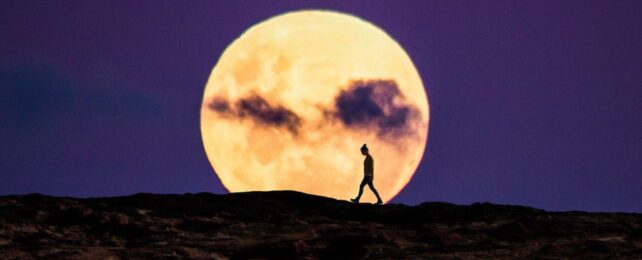Once in a blue moon, Earth's skies host a 'blue supermoon', and the beautifully bright sight is one that you don't want to miss.
Otherwise, you won't have a chance to glimpse a similar phenomenon until 2032.
If your eyes are peeled for a blue-colored Moon, however, you're going to be disappointed.
Despite the name, a blue moon doesn't actually shine azure or cerulean. In fact, it's a bit uncertain as to how this term came about.
Centuries ago, it seems to have been used to describe an impossible event, kind of like 'if pigs fly'.
After a volcanic eruption in the 1800s, however, the sky really did turn a strange color, giving the Moon a blueish filter. Colloquially, a 'blue moon' came to refer to a rare event that only occurs every now and then.
Today, in technical astronomical terms, a blue moon is when four full moons fall within the same season, as opposed to the usual three. More recently it's also come to describe a second full moon that gets squeezed into a single calendar month.
A supermoon, meanwhile, is when the Moon's closest approach to Earth in any single orbit lines up with a new or full phase.
If both factors occur at once, it's called a 'super blue moon' or 'blue supermoon'.
Of all four supermoons that will occur in 2023, August is hogging two of them.
The first will rise on the first day of the month and will appear roughly 7.1 percent larger and nearly 15.6 percent more luminous than the average full moon.
If you don't have a chance to go outside and see it, the Italian astronomer Gianluca Masi will provide a live webcast of the Moon rising over Rome's Coliseum, as part of his Virtual Telescope Project.
"My plans are to capture the beauty of this … hopefully bringing the emotion of the show to our viewers," Masi told PBS.
Even if you happen to miss that supermoon, you won't have long to wait for another.
The second will occur just 28 days later on the 31st of August. It will be 0.1 percent bigger and brighter than its predecessor.
According to the Farmer's Almanac, which has tracked the Moon's movements for centuries, this particular blue moon will be the "closest, biggest, and brightest full supermoon of 2023".
Even though neither of these Moons will appear blue, they may look slightly orange.
This is because full moons in August tend to approach Earth lower on the horizon. Like a sunset, this means shorter wavelengths of light, like blue, are reduced as they scatter through the atmosphere, leaving longer wavelengths like red and orange to shine through.
The last time a blue supermoon of this kind graced our skies was five years ago in 2018, and back then, it was even redder than normal.
Technically, this was a 'super blue blood moon', because not only was it the second supermoon of the month, it also occurred during a lunar eclipse, when Earth's shadow completely covered our neighboring satellite.
This gave the Moon a large, bright, and reddish appearance as can be seen in the video below.
The next one of these trifecta lunar events isn't due until January 31, 2037.
Until then, we'll have to make do with two orange-y super blue moons – one this August and another in August of 2032.
